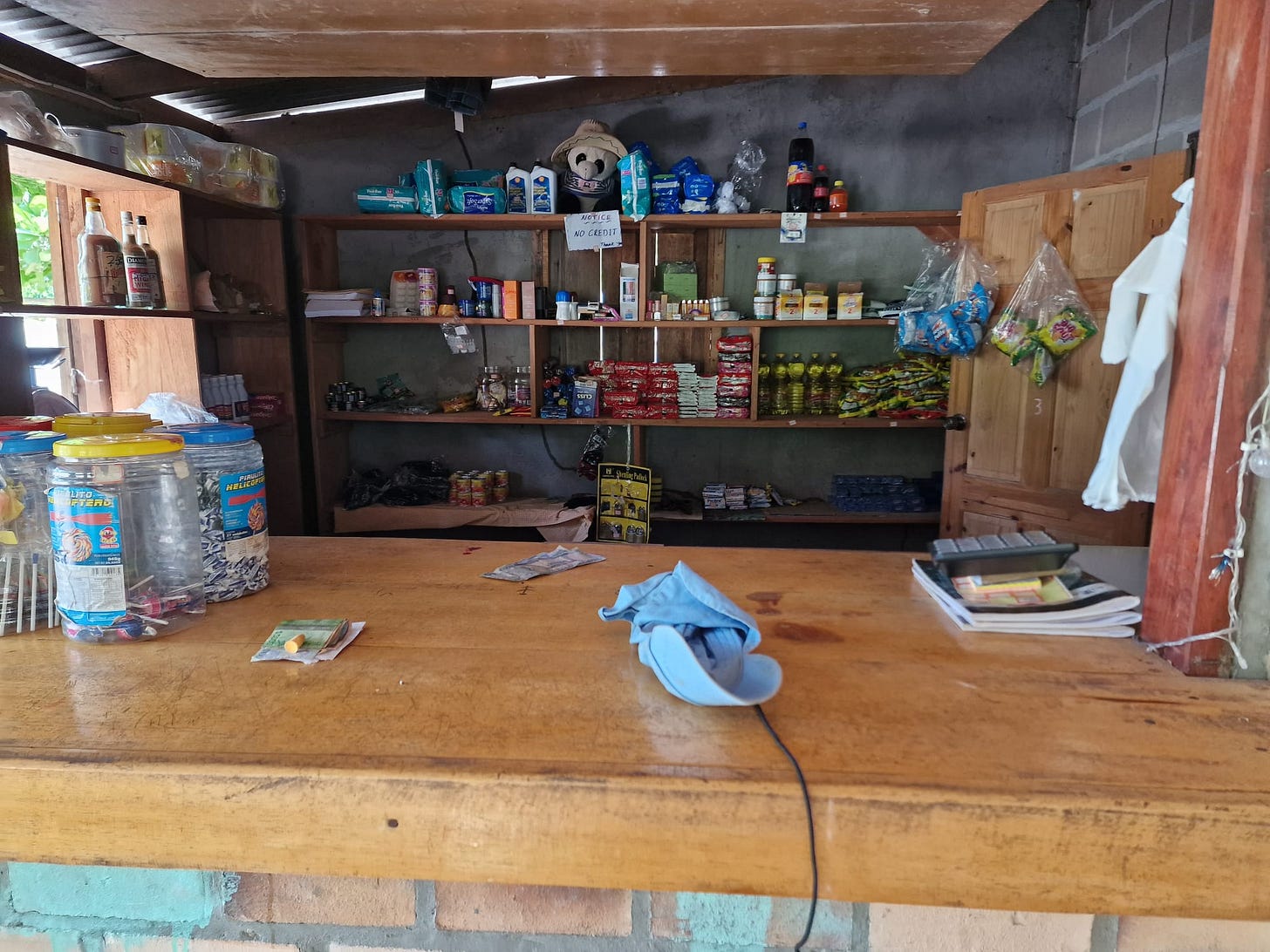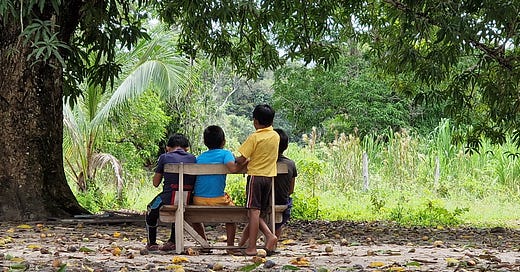My daughter came running back to camp, holding up the edge of her t-shirt as a make-shift basket. There was yellow juice on her face.
“We all climbed the tree of the man with just one foot!” She dumped out the load of mangoes from her top and beamed at me. “Ok! I have to go back! Bye!”
With that she was gone.
Rainy season was just starting in Southern Guyana and every mango tree in the village was fruiting at the same time. The village children, ours included, were on a mango-heavy diet. Their days went something like: mangoes for breakfast, find one to eat on your walk to school, climb the tree to get one at break time, get given one for lunch and another for lunch break, and, of course, fill your t-shirt with them before heading home.
My partner and I had expected certain intestinal… consequences from this abrupt shift to a fruit-rich diet, but, to our surprise, we saw none. Not that consequences would have stopped the kids. With no way to store fruit, if they wanted to enjoy mangoes at all this year, it was now or never. And enjoy they really, really did.
Part of the village’s single-minded slightly manic pursuit of Mangifera indica has, for generations, been driven by the otherwise repetitive nature of the village diet. Two or three major carbohydrate sources can only pair with two or three major protein sources in so many ways. The season of a fruit is a blessing, a welcome change of diet, and is to be enjoyed as much as possible while it lasts.
But another dietary shake-up came to this village about 30 years ago. Improved roads to a village downstream meant the arrival of a weekly boatload of ultraprocessed food. Without cold-storage, there's no ice-cream or chocolate, but sweets, biscuits, and soft drinks became available to anyone with a few pence.
Learning that the community's adult health had crumbled in the time since didn't surprise me. Almost all middle-aged adults now suffer from hypertension, type 2 diabetes, or uterine fibroids. The healthcare system, such as it is, had no chance of keeping up with demand. All what you'd expect.
What did surprise me was seeing that, despite the unmissable catastrophe wrought by this dietary change, parents (mothers in particular) are delighted at how these new sugary foods and formulas make their babies grow. In a culture with an all too recent memory of losing children to hunger, a chubbier baby can't look anything other than reassuring. An example of the cultural blindspots that sugar is hiding in while it's happily knocking-off literally billions of life-years all over the planet.
Another blindspot is the murky maths of pleasure now vs. happiness later. All of us want our children to be healthy now, to be happy now, to live long and happy lives, and to learn enough that they can contribute to their families and societies. But, a lifetime is a long way in the future, it’s really hard to know how we set that up in our children.

I work with big companies who want to answer the same question. To be clear, these (mostly) aren't charities. They want to know the secrets to lasting health because they quite reasonably assume that people will pay for that. But, it’s a very difficult equation - how do we weigh up things that cause pain, things that cause school difficulties, things that cause poor mental health, things that lead to increased risk of death in children if we have to trade them off against each other. These are emotive subjects, with thousands of layers of complexity. Forget trying to compare apples and oranges. Think apples and musical notes. Or battleships.
Part of my job is triage - ranking the problems in order to find the first one to solve. Recently, we’ve been looking at child growth and development challenges in low and middle income countries. I decided to start by looking at the two lists of major diseases: what is it that these children are most likely to die of, and what are they most likely to spend their lives suffering from before they do?
For the first time in this story, intuition matches statistics: there is a very strong correlation. In fact, it's pretty much the same list - the diseases that make your life worse are roughly the same things that make it shorter. And, all over the world, that is becoming more true with every passing year. We used to think that this convergence was solely down to improvements in tackling infectious diseases. Now it looks like something more sinister might be going on.
What do most people suffer and die from?
So, what is this list of major things that will make the lives of current children shorter and less enjoyable? Heart disease, stroke, cancer, diabetes and chronic lung disease. And other ones too - kidney disease, liver disease, and neurodegenerative disease (like Alzheimer’s disease and dementia - one of the top five causes of death in the UK, but not yet globally).
All of these Big Five are so-called Non-Communicable Diseases (NCDs). They are caused by the environment in which you find yourself. That environment includes your food, your air, your water, all that stuff. Luck, genetics, and your behaviour towards that environment all play minor parts too. Between them, just these five diseases cause about three quarters of all deaths globally and a huge proportion of the illness and suffering. That number and proportion are both rising fast.
On average, if you’re a child growing up in a low-income country (even excluding infectious disease risk) you will die sooner. Weaker environmental regulation and less developed healthcare systems are an unfortunate combination. Vice versa, if you live in a high-income country, you may be partially protected by regulation, and you may be better sustained by the healthcare system, so your death will come later. On average.
Ok, here is where things get interesting. Now we grasp the stats and the shape of the challenge, we have to uncover the causes of those five major NCDs. Many people have done this, to various degrees. It was easy to pull together a diagram showing the key contributing syndromes - high blood pressure, atherosclerosis, metabolic syndrome, chronic inflammation, and more. The diagram gets a little tangled because most of these syndromes contribute to most of the diseases but it's still very understandable and very well known.
Most research papers stop there. Disease X is caused by inflammation in the Y and this is caused by ‘Western Living’. QED. All solved. Next grant please.
It's not been until more recently that researchers have stopped thinking like butchers and started valuing the connections between body parts. We humans are (each and together) a great big complex, connected system.
And if you, say, spend hundreds of hours reading the most recent papers on exactly how cells die and organs fail during those causative syndromes, but you're looking for connections, then a big picture emerges: while our symptoms may differ (because genetics or exposure damaged one organ system slightly faster than the others), the pathology that drives the Big Five NCDs appears to all have the same underlying cause.
What causes our bodies to fail?
While not all researchers agree, their results appear to: high levels of a chemical called fructose inside cells changes how those cells behave, which eventually causes the type of organ system failure that produces all of the Big Five NCDs. Different distributions of damage show up in different ways, but eventually this change in cellular behaviour kills people in a few common, predictable ways.
Currently, the most complete and best evidenced hypothesis for how fructose causes this change in cellular behaviour comes from Dr Richard Johnson and team at the University of Colorado. They describe fructose as a signal that the body is likely to face a time of physiological hardship - starvation, dehydration, or hibernation. Fructose is metabolised through a pathway that uses up the cell’s energy - not completely, but enough to make the cell signal that it is running out of food. This then sets off a cascade of signals throughout the whole body that make it:
Search for food and water - it stimulates hunger and thirst, makes us hyperactive to search for food (the ‘foraging response’) and makes it hard to feel full
Store more fat - it stops our usual body-fat-sensing pathways from sensing our fat, and stimulates the body to make more fat
Conserve energy - it reduces resting energy metabolism, induces insulin resistance which reduces muscle energy use, and reduces brain energy metabolism associated with self control. (I reckon this may explain why average human body temperatures have been decreasing over the last few centuries - see reference below)
Enter ‘low-power mode’ - it makes our mitochondria work less and use less oxygen (I wonder whether this reduced oxygen requirement piece may be linked long-term to some of the changes seen in lung disease, but this isn’t yet explored. Maybe it’s just the from the inflammation)
Activate the immune system - it stimulates innate immunity and induces mild systemic inflammation
These are all absolutely critical emergency responses to times of hardship. Without them we wouldn't be able to survive things like starvation as well as we can. They might even be some of the features that helped our ancestors survive their journey out of Africa and spread over the whole planet.
But, like all emergency responses, they're built for the short term. If you leave these things running, they combine to create disease. They will worsen and shorten the lives of most children born today. Fructose in your cells is a big deal.
Why is fructose in your cells?
A long time ago, fructose showed up inside cells when carbohydrate metabolism overflowed. This could happen when you suddenly found a huge stash of carbs (e.g. local fruit or nut trees came into season) or if one of your help-I'm-not-OK enzymes (in this case, aldose reductase) got turned on by low-oxygen or dehydration. These are all rare markers that things are about to get difficult. When they happen, your body needs to listen to them. Fruit trees don't fruit for long, and it can be a while before they do it again. Dehydration may herald the oncoming dry season.
Nowadays, there's a much more common and much more effective way to get fructose into your cells. Eat it.
Fructose is a sugar. Paired with glucose, it makes sucrose, which is what the whole world knows as ‘sugar’. We've always had access to fructose. Plants put it in fruit to make them sweet. It's the reason that my children became more mango than human for a few weeks in the Amazon. And this history lends it a disguise. Fructose can’t be bad for you! It’s in fruit, for Pete’s sake! It’s in the name, see? ‘Fruct - Ose’. ‘Fruit - Sugar’. And fruit is healthiness incarnate!
Ok. that’s a compelling argument. If we’ve always had fructose, why is it causing a problem now?
Because for most of human history, certainly when we were inventing our cells’ emergency survival systems, sugar was not a major component of our diet. Fruit was limited and occasional (unlike leaves, stems, and roots (or ‘vegetables’), which are available, albeit at different sizes, through most of the year). If we were all to eat mangoes, continuously, at the rate my children did, then we might see problems.
But even then we’d be mostly protected by the plant itself. Fruits package the fructose up in cells, massively slowing down its release in our digestive system. This delayed release allows the liver time to metabolise (‘detox’, if you want to be millennial about it) before it reaches most of the cells in your body. Fruit sends a trickle of fructose to your cells. Once that sugar is out of the fruit cells, once it’s in a juice, or a smoothie, or any of the million sugar-sweetened foods in a supermarket, it will arrive at your cells as a flood. That is what is driving most of the global health catastrophe.
For scale, in the year 2016, the average UK 5-year-old consumed their bodyweight in added sugar. Sugar is no longer an occasional flavour in some parts of the diet, every now and then. Nowadays it is constant. Added to that, aldose reductase is finding its ‘low-oxygen’ trigger in reduced blood flow caused by sedentary lifestyle and its ‘dehydration’ trigger in high-salt foods. Our emergency survival responses are being triggered at full volume, all day and all night.
Our bodies cannot thrive if they are continually trying to survive. High levels of fructose in cells is the unifying route through which a Western (or, increasingly, global modern) lifestyle damages health.
(NB. Maybe you’re thinking ‘but these non-communicable diseases are all about fat. Where’s the fat?’ Fructose makes our bodies want to eat more fat and store more fat, but fat itself doesn’t drive the metabolic syndrome and cellular damage. People who eat high-fat, high protein diets without carbohydrates don’t get sick from this. Certain dietary fats cause other problems, but they are not the big players in non-communicable disease).
I was stunned when I learned this. I’ve spent a decade helping organisations and parents understand the effects of the environment on children’s long-term health, but even I was shocked when I understood the mechanism by which our diet creates the diseases that make us suffer and die.
What does this mean for children?
So fructose in cells makes bodies sick and die as adults, but what does it do to children?
Tooth decay
Look, let's get tooth decay out of the way first. It is a red herring. The link between sugar and tooth decay is easy to understand and impossible to deny. It's become a very useful distraction for companies that want to keep on selling sugar to kids. Every time someone in the media notices that sugar might be problematic, they can wheel out that same rhetoric. ‘Yes!’ they say, ‘Sugar causes a problem. That problem is called tooth decay and you can fix that by brushing. So we're good to go! Sundaes all round!’. Tooth decay is not the extent of the damage that sugar does to children. It's not even the tip of the iceberg. The answer ‘Tooth decay’ is to the question ‘What's the health cost of sugar?’, as ‘His weird chin dimples’ is to ‘What's wrong with Elon Musk?’ - not technically incorrect, but you're missing 99.9% of the answer.
So what does this mean for children? Let's start early.
Placentas and pre-eclampsia
We remember aldose reductase from six paragraphs ago? It increases fructose production inside cells in response to low-oxygen to help them survive, right? Well it turns out to be very active, as you might expect, in the fetus during some parts of pregnancy. The more toxic effects that that much fructose could have on the placenta are prevented by some clever moderation of the levels and frequency. And they have to be, because there's a vicious cycle just there waiting to catch the unwary: if fructose levels get too high, they can reduce the efficiency of the placenta, reducing the rate of oxygen transfer to the fetus, increasing the production of fructose, raising the levels of fructose. That's the mechanism behind pre-eclampsia, which kills more than a thousand babies in the UK each year. Anything that boosts the level of fructose passing through the placenta narrows the safe region within which unborn babies can try to protect themselves from oxygen starvation.
Priming for metabolic disease
There's another interesting effect of passing fructose through a placenta - the baby on the other side of it gets primed for a high-risk life. Well something must be causing all this fructose in the blood, right? It must be a war zone out there! So, with a few little pieces of epigenetic modification, it sets up lasting survival mechanisms. Things like reduced metabolism, increased appetite, and critical emergency responses even more sensitive to fructose. The baby becomes more likely to survive hardships, but also more likely to suffer from those big five non-communicable disease.
Behavioural disorders
Once the baby is born, they can (given the right set of grandparents) really go to town on the white stuff. And if/when they do, the responses to the fructose really affect their little lives quite immediately.
I mentioned that the uric acid generated by high fructose drives us to “Search for food and water”. Scientists describe it as a ‘hyperactive foraging response’ that stimulates craving, impulsivity, risk taking and aggression. In adults with our (*self-flattery alert*) more developed self-control, this can be tempered. In young children it is very easy to see in their external behaviour and is thought to contribute to ADHD, bipolar disease, and aggressive behaviours. Some scientists have gone so far as to say that most cases of these diseases could represent a chronic response to a high-sugar diet in people who have genes or environmental exposures that make them more susceptible.
Sleep abnormalities
I was recently talking with a professor of sleep medicine who mentioned that babies today seem to wake much more frequently overnight than the babies of sixty years ago. No one seems to know why. We do know, however, that high-sugar, high-GI diets seem to increase the risk of insomnia in adults. We also know that high-sugar diets affect satiety and appetite. And we know that the majority of babies in the western world get free sugar (i.e. sugar that is not bound without fruit cells - anything from a smoothie to a smartie) through breastmilk or in weaning foods. No-one’s yet done the study to see if this is having an effect on how babies sleep, but I wouldn’t be at all surprised if a chemical that trashes sleep and stimulates appetite might have an effect.
Addiction
And then finally, or not so finally because it happens really darned fast: it’s addictive. I couldn't have said that so confidently five years ago, but recent studies are being much more certain in their findings: sugar is addictive. It hits the exact same pathways as addictive drugs, makes you more likely to become addicted to other things, and makes addicts suffer withdrawals when they try to stop.
What can parents do?
Ugh, this is really tough going. I’m sorry folks. Anyone who’s ever grown a baby is probably either having a self-protective “Is any of this even true?” reaction (in which case you should check the references) or looking back and thinking “Damn, if I’d known this earlier, I’d probably do a few things differently.” And, sure, earlier is always easier. However, human bodies are amazingly adaptable, and we can improve health from almost any starting point. To understand how, we need to dive back into the biology…
To avoid the problems caused by fructose inside cells, we need to look at stopping the fructose getting into those cells. There are two ways to do that:
Block aldose reductase
Stop eating sugar
Which is going to be the most effective? Thankfully for us, various scientists also went looking for the answer to that question. They blocked aldose reductase (in a few quite inventive ways) and looked at the effects on fructose levels and markers of the Big Five NCDs. Their results were very underwhelming. The problem is that fructose is such a good signal that only tiny amounts are needed. For every 100 glucose molecules in the cell, the enzyme can only generate a maximum of about three fructoses. Blocking it has about 3% of the effect of not eating those 100 glucoses as sugar (in which form, they’d come pre-packaged with a fructose each). So much for our get-out-of-jail-free-pill.
Ultimately, the “single biggest thing we can do to set children up for a long, healthy, happy life” turns out to be stop them eating sugar. It was a close competition. Honourable mentions need to go to “Keep them moving”, “Help them sleep”, and “Teach them to understand their bodies” (with “Make sure they’re born wealthy” having earlier been disqualified for cheating).
Look, I have close family members struggling with sugar addiction, I know how hard restricting sugar consumption is, even for adults. And I know how painful retrospective guilt is, I’ve been there way too often. But this isn’t about what’s happened so far, it’s about an easy, cheap, effective way to add more health and longevity into children’s futures. Wherever you're starting from, you can make an enormous difference now.
Some options for action:
Do everything you can to cut out sugar yourself. If you are pregnant, you avoid priming your baby. If you have children in your house, you avoid modelling sugar consumption.
Delay baby’s first taste of sugar for as long as you possibly can. Every extra 24 hours makes a difference.
Follow the anti-addiction advice in last week’s episode (i.e. 2025. No1: “Candy crushed” - What we can learn about raising children who don’t want sugar from the advice on raising children who don’t want to smoke), but in a nutshell, some things to focus on are:
Never model eating sugar - Kids want to be adults. Don’t teach them that adults eat sugar.
Make snacks healthy - Are they hungry between meals? Kids with vegetables to snack on, snack on vegetables. Parents influence this, but so do schools and local authorities.
Fight the association of sweet foods with celebrations and treats - Want to set children up to turn to friends other than Ben and Jerry in times of stress? Restricting access to a food other than “special occasions” is the best way to anchor it into someone's mind as a ‘good thing’. If we, as a society, did this with, say, shell-on walnuts instead of ice-cream or chocolate, we’d have very different health (and much less nut allergy, but that's off topic).
Understand the severity - For many, sugar-sweetened food is utterly inescapable, especially if introduced in the first few years. It's hard to learn to love other foods if you're continually craving just one. I'll keep this simple and reiterate it: no sugar in the home.
Choice of amounts - Dessert is not as common a phenomenon as we’re taught. In most places, meals are one course. Without the lure of something sweet, kids don't push themselves to finish their plate - finishing only as much as they want. They learn to listen to their body’s ‘I'm full’ signal, and hold onto this knowledge for life. If you want to give different foods, don’t give courses, give a little bit of each of them simultaneously.
Too late to avoid introducing sugar? It’s time to put boundaries on sugar intake. The WHO recommends no more than 20g of sugar for a seven-year-old each day. The NHS increases this recommended “ultimate safe limit” to 30g/day (for no reason that I can find). Care to guess how many UK seven-year-olds eat 30g/day of sugar or less? Go on. Just guess. I’ve put the answer at the end. You can check how close your guess was and consider how worrying that is.
Sugar is a woven into the very fabric of our lives and culture. It’s touted as the ultimate expression of love between parents and children. But now we know what we know about the single unifying route into the Big 5 non-communicable diseases, we’re torn. To get past this we need to recognise that we ourselves have grown up within a broken food environment and that we, and almost everyone we see, is suffering the consequences. We have the opportunity to really do something special for the UK’s children’s future.
What are you going to change first?
It’s 1.5% by the way.
You might also like
Prefer a podcast?
References
Fructose driving a cellular survival pathway: https://onlinelibrary.wiley.com/doi/full/10.1111/joim.12993
Fructose and preeclampsia: https://www.nature.com/articles/s41440-022-01121-w
Fructose, the hyperactive foraging response, and behavioural disorders: https://www.sciencedirect.com/science/article/abs/pii/S1090513820301215
Are humans getting cooler? https://elifesciences.org/articles/49555
Human body temperature and metabolic changes: https://pmc.ncbi.nlm.nih.gov/articles/PMC2744512/
High-sugar, high-GI diets and insomnia https://www.sciencedirect.com/science/article/pii/S0002916522010188
High-sugar diets and appetite regulation https://www.frontiersin.org/journals/nutrition/articles/10.3389/fnut.2015.00005/full
Sugar’s effects on substance-use disorders https://www.mdpi.com/2072-6643/14/14/2940
Lung disease linked to sugar consumption? I was surprised too. But there is observational evidence linking dietary sugar to chronic lung disease, and mechanistic evidence from animal studies: https://www.nature.com/articles/s41598-019-45594-1











I often pair fruit with cheese or nuts, to slow the digestion of sugar. I do this with my toddler and from my understanding I thought this was ok! I definitely notice a difference if he has fruit on its own.
Such an important article, thank you. Have long buried my head in the sand about sugar because it’s so ingrained in me to see it as a ‘treat’ and a small moment of joy in the day, which now feels even more impossible to give up as a tired new parent.
We’re starting to introduce our baby to solid food, so have a massive opportunity to get it right for them… I wanted to clarify your thoughts about fruit. I can see that in trying to limit sugary trash it must be tempting as a parent to just constantly reach for fruit as a substitute (so kids don’t miss out on the ‘something sweet’ at all the times our culture demands it). Based on your article though, am I right in thinking you would recommend delaying introduction to fruit because, although not harmful like added sugar, it could build an unnecessary early desire for sweet foods? And, once introduced, limit fruit to small portions only occasionally?